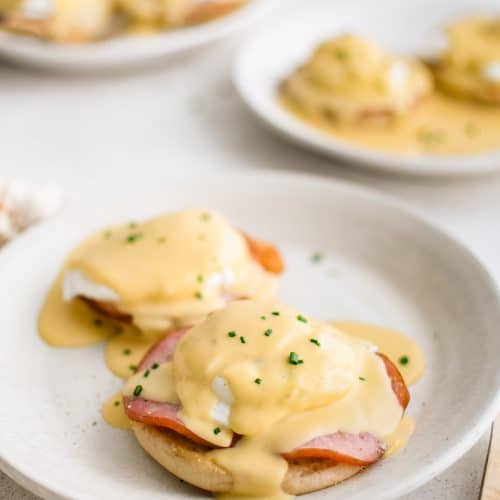Made with poached eggs, Canadian-style bacon, and homemade Hollandaise Sauce on a toasted English muffin, this classic Eggs Benedict Recipe is easy to make. A popular American brunch dish, it’s the perfect weekend treat or holiday breakfast option.

Eggs Benedict is my FAVORITE breakfast dish. I will never turn down an opportunity to devour a plate of golden, runny egg yolks mixed with salty hollandaise sauce.
The Best Eggs Benedict
Today, I’m showing you how to assemble the perfect eggs Benedict in just over 30 minutes and with simple ingredients.
All you need are English muffins, butter, Canadian-style bacon, poached eggs, and hollandaise sauce. If you know how to toast muffins and fry up some bacon, you’re halfway there. And if you’re new to poaching eggs, I’ve got you covered! Here, you’ll find step-by-step instructions to make perfect poached eggs, or you can find all you need to know about poaching eggs in this post. You can also follow my super easy recipe for homemade hollandaise sauce – you can even make it ahead for added convenience.
Impress yourself and your loved ones with this irresistible Eggs Benedict recipe. They’re also great for special occasions like Mother’s Day, Valentine’s Day, birthdays, and holidays.
What is Eggs Benedict?
Eggs Benedict is a traditional American dish, commonly enjoyed for breakfast or brunch. It consists of toasted English muffins that are loaded with crispy slices of bacon, poached egg, and a smothering of creamy hollandaise sauce.
Eggs Benedict first became popular in New York City in 1894 and has been offered in restaurants and diners or made-in-home kitchens ever since!

Key Ingredients
Find the printable recipe with measurements in the recipe card below.
There are four key components to classic Eggs Benedict. They are:
- Poached Eggs: I highly recommend glancing over How to Poach an Egg for full details, tips, and tricks on making perfect poached eggs.
- Hollandaise Sauce: Hollandaise sauce consists of egg yolks, butter, lemon juice, salt, back pepper, and (sometimes) cayenne or ground nutmeg. It is one of the classic French sauces that seem intimidating but is actually quite easy.
- Ham or Bacon: Traditionally, Eggs Benedict was made with Canadian bacon, which has more of a ham-like texture.
- English Muffin: The English muffin is sliced in half, toasted lightly, and buttered.
How to Make Eggs Benedict
1. Toast the Muffins: Melt the butter in a skillet over medium heat and toast each side of the sliced muffin halves for about 2 minutes per side or until golden. Set the toasted muffins aside.


2. Fry the Bacon: In the same skillet, add the bacon slices and fry for a minute on each side until golden and lightly charred on the edges.

3. Poach the Eggs: Boil 3 inches of water in a wide pot over high heat. Once the water boils, reduce the heat so that water comes to a gentle boil and stir in the vinegar. Crack each egg into a separate small bowl and gently slide the eggs, one at a time, into the simmering water. Note: Any loose egg white pieces and foam can be scooped out using a fine strainer. Cover the pot with a lid and let the eggs cook for 2-4 minutes, depending on how jammy you like the egg yolks. Remove the cooked eggs from the pot using a small strainer and place them on a plate.


4. Assemble the Muffins: Assemble by placing two muffin halves on a plate, add a slice of Canadian bacon (or two) and top with a poached egg. Sprinkle with salt and pepper, and drizzle a generous amount of hollandaise sauce over the top of the egg. Repeat this for all 6 muffins.
5. Optional Garnish: If you like, sprinkle freshly sliced chives over the hollandaise sauce just before serving your eggs benedict.

Recipe Tips
- Fresher eggs always equals better poached eggs. Old eggs are watery, so they don’t hold together as well.
- Use a large, wide saucepan to accommodate poaching six eggs at one time. Otherwise, poach the eggs in batches.
- It’s normal for the water to cool slightly once the eggs have been added. If the temperature drops too much, increase the heat slightly to get it back to a low simmer, but be careful not to create a rolling boil.
Variations
There are countless variations of eggs benedict. Here are some of the most famous:
- Eggs Florentine: Made with sauteed spinach in place of the Canadian bacon. A popular choice for vegetarians.
- California Benedict: The Canadian bacon is replaced by avocado and (sometimes) tomato.
- Eggs Royale (or Eggs Atlantic): Smoked salmon takes the place of Canadian bacon.
- Crab Benedict: Crab meat or crab cakes replace Canadian bacon (one of my personal favorites!)
- Country Benedict: A biscuit replaces the English muffin and a sausage patty or slice of ham replaces the Canadian bacon. It is usually topped with country gravy instead of hollandaise sauce.
- Huevos Benedict: In this variation, chorizo or avocado (or both) replace the Canadian bacon, and sometimes a spicy hollandaise or tomato-based sauce is used in place of traditional hollandaise.
- Irish Benedict: Corned beef or Irish bacon replaces Canadian bacon.

Why is it Called Eggs Benedict?
This dish was named after Lemuel Benedict, a resident of New York City, who ordered the combination of “buttered toast, poached eggs, crisp bacon, and a hooker of hollandaise” at the Waldorf Hotel in 1894. It shortly grew to fame after that and has since become an iconic American dish, commonly served for breakfast or brunch.
What to Serve with Eggs Benedict
Although Eggs Benedict can be quite filling, consider pairing your assembled muffins with:
- Roasted Asparagus
- Fried Potatoes and Onions
- Crispy Hash Browns or Breakfast Potatoes
- Salmon
- Strawberry Spinach Salad
- Easy Fruit Salad
- Mimosas

Storage
Once assembled, it’s best to serve eggs Benedict immediately. They aren’t suitable for storing as the muffins will turn soggy quickly. Freezing is not recommended.
More Breakfast Recipes
- Quiche Lorraine
- Breakfast Casserole
- Croissant Breakfast Sandwich Recipe
- Overnight Oats Recipe
- Crustless Quiche
- Tater Tot Breakfast Casserole
If you try making this Eggs Benedict Recipe, please leave me a comment and let me know! I always love to hear your thoughts.

RECIPE CARD

Eggs Benedict Recipe
Ingredients
- 3 English Muffins - each sliced in half
- 6 slices Canadian Bacon
- 2 tablespoon butter
- 6 large eggs
- 1 tablespoon distilled vinegar
- ½ teaspoon salt
- 1 cup hollandaise sauce - freshly made
Instructions
- Melt the butter in a large skillet set over medium heat and toast the muffins until golden on both sides, about 2 minutes per side (see notes).
- Fry the bacon in the same skillet on both sides until golden and lightly charred on the edges, about a minute on each side.
- Heat 3 inches of water in a large, deep skillet set over high heat until it reaches a boil, then reduce the heat so that the water calms to a gentle boil.
- Pour in the vinegar then crack each egg into its own small bowl and gently slide them into the water. (Little whisps of egg white will form around the egg, use a small strainer to strain them out along with any white foam that forms at the top.)
- Cover the pot with a lid and let them cook for 2-4 minutes depending on how jammy you like your eggs. Then use a slotted spoon to remove the eggs and transfer them to a plate.
- To assemble, place two English muffin halves on a plate and layer with a slice of bacon or two followed by a poached egg. Right before serving, sprinkle the egg with salt and pepper and pour a generous amount of hollandaise sauce on top.
- Garnish with freshly sliced chives if desired and serve immediately.
Jessica’s Notes
- Feel free to toast the English muffins in a regular toaster oven if that’s preferred.
- For best results, always use fresh eggs when making poached eggs.
- Eggs benedict should be served as soon as they are assembled. Homemade hollandaise sauce can be stored in an airtight container in the fridge for up to 2 days.
Nutritional Information
(Nutrition information provided is an estimate and will vary based on cooking methods and specific brands of ingredients used.)




Last Updated | 0 Comments